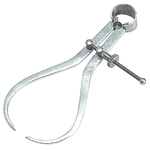I've been turning pens for a little while now. Didn't get a lot of time in the shop last year, but overall, I'd say I have about a year, or so, under my belt. I went TBC....well, I guess, around the end of 2021, based on things I learned here on these forums. I turn between 60 degree centers with TBC bushings, until I get close to the bushing, then put the blank directly between centers for final turning and finishing.
I'm wondering, for those of you who do things this way, how you measure your final diameters? I have a digital caliper, and am looking to improve my technique, accuracy, and speed at getting down to the right diameter at the ends of each blank. I have had some trouble, getting those measurements. Like most digital calipers of this class, I think, there are two ways to measure...outside diameter, and inside diameter. I've tried both. I have tried using the inner part of the outside diameter side of the calipers, as well as the tapered outer part. The inside part, if you have any kind of curve to your blank, is hard to get an accurate read with... However, using the thin tapered outer tips of this part of the caliper, is often very hard to get right at the end of the blank...so its not necessarily, at least in practice for myself so far, been much more accurate.
I've also tried to use the inside diameter tips of the caliper. I feel like that should be a more accurate way of measuring...but, it can be tough to actually get those tips at exactly the surface of the blank... Since you are not clamping down on anything...there is no natural stop for the tips, and getting an accurate read is still tough.
Anyway, I'm wondering if anyone has a particular technique that works really well, for caliper measurements. I still get a bit of wobble with bushings, even the high quality TBC bushings from TBCBushings.com. I am not real sure why, although I have several ideas. Anyway, in order to get optimal concentricity and roundness, I'm trying to do final turning and sanding without any bushings, with caliper measurement to try and get a perfect fit between the blank and kit parts.
I'm wondering, for those of you who do things this way, how you measure your final diameters? I have a digital caliper, and am looking to improve my technique, accuracy, and speed at getting down to the right diameter at the ends of each blank. I have had some trouble, getting those measurements. Like most digital calipers of this class, I think, there are two ways to measure...outside diameter, and inside diameter. I've tried both. I have tried using the inner part of the outside diameter side of the calipers, as well as the tapered outer part. The inside part, if you have any kind of curve to your blank, is hard to get an accurate read with... However, using the thin tapered outer tips of this part of the caliper, is often very hard to get right at the end of the blank...so its not necessarily, at least in practice for myself so far, been much more accurate.
I've also tried to use the inside diameter tips of the caliper. I feel like that should be a more accurate way of measuring...but, it can be tough to actually get those tips at exactly the surface of the blank... Since you are not clamping down on anything...there is no natural stop for the tips, and getting an accurate read is still tough.
Anyway, I'm wondering if anyone has a particular technique that works really well, for caliper measurements. I still get a bit of wobble with bushings, even the high quality TBC bushings from TBCBushings.com. I am not real sure why, although I have several ideas. Anyway, in order to get optimal concentricity and roundness, I'm trying to do final turning and sanding without any bushings, with caliper measurement to try and get a perfect fit between the blank and kit parts.


